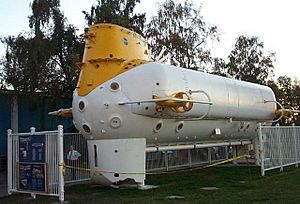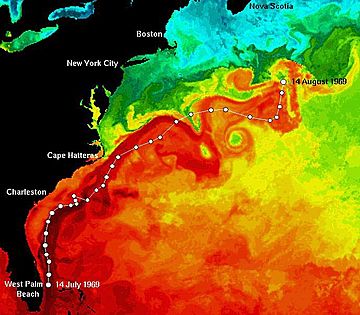Ben Franklin (PX-15) facts for kids
 |
|
Quick facts for kids History |
|
|---|---|
| Name | Ben Franklin |
| Namesake | Benjamin Franklin |
| Builder | Giovanola/Grumman |
| Laid down | 1966 |
| Launched | 1968 |
| In service | 1969 |
| Out of service | 1971 |
| Status | Museum ship |
| General characteristics | |
| Type | Submersible |
| Displacement | 130 long tons (132 t) |
| Length | 48 ft 9 in (14.86 m) |
| Beam | 21 ft 6 in (6.55 m) |
| Height | 20 ft (6.1 m) |
| Propulsion | 4 × electric motors, lead batteries |
| Test depth | Crush depth: 4,000 ft (1,200 m) |
| Crew | 6 |
| Armament | None |
The Ben Franklin is a special underwater vehicle, like a mini-submarine, built in 1968. It's also known as the Grumman/Piccard PX-15. This amazing research vessel was created by the famous explorer and inventor Jacques Piccard. It was designed to hold a crew of six people. They could live underwater for up to 30 days! Their mission was to study the deep Atlantic Ocean in a powerful current called the Gulf Stream. Even NASA (the space agency) was interested. They wanted to learn how people cope with living in a small space for a long time. This helped them prepare for long space missions.
| Top - 0-9 A B C D E F G H I J K L M N O P Q R S T U V W X Y Z |
Building the Ben Franklin
The Ben Franklin was built in Switzerland between 1966 and 1968. It was a team effort by Piccard and the Grumman company. After it was finished, the submersible was taken apart. Then, it was shipped all the way to Florida in the United States. This vessel was the first submarine built to very strict safety rules. These rules are set by the American Bureau of Shipping (ABS).
How Deep Can It Go?
The Ben Franklin was designed to handle incredible pressure. It could go as deep as 4,000 feet (1,200 m) (about 1,200 meters) before it might crush. Its goal was to float along naturally. It would drift at depths between 600 and 2,000 feet (180 and 610 m) (180 to 600 meters).
Size and Power
This 130-ton ship is quite large for a submersible. It is 48 feet 9 inches (14.86 m) long, which is about the length of a school bus. It is 21 feet 6 inches (6.55 m) wide and 20 feet (6.1 m) tall. The Ben Franklin has four electric motors on the outside. These motors help it move up and down in the water. It gets its power from many heavy lead batteries stored outside its main body.
Many Windows for Viewing
Jacques Piccard really wanted to see the ocean clearly. He insisted on having 29 observation windows, called portholes. Engineers were worried these windows might be weak spots. But Piccard believed they were important for studying the ocean.
The Historic Gulf Stream Drift Mission
The Ben Franklin began its most famous journey on July 14, 1969. It started off the coast of Palm Beach, Florida. Jacques Piccard was the leader of this mission. The submersible drifted for a whole month. It was followed by support ships on the surface.
Journey's End
On August 14, 1969, the Ben Franklin came back to the surface. It had traveled 1,444 miles (2,324 km) (about 2,300 kilometers). This was about 300 miles (480 km) (480 kilometers) south of Halifax, Nova Scotia, Canada. This long journey proved that humans could live and work underwater for extended periods.
Later Dives and Discoveries
After its big drift, the Ben Franklin made a few more dives. One of these dives was very special. It was the first deep-sea dive for Robert Ballard. He later became famous for discovering the wreck of the Titanic.
Where is the Ben Franklin Now?
In 1971, the Ben Franklin ran aground on a reef. It was then sold to a businessman in Vancouver, Canada. For almost 30 years, it sat unused on the North Shore. In 1999, a decision was made to either move or scrap it. Luckily, it was offered to the Vancouver Maritime Museum. After being fixed up, the Ben Franklin was placed in front of the museum. Now, it is a Museum ship that people can visit and learn from.
Meet the Crew
Six brave people were part of the Ben Franklin's crew during its long mission:
- Jacques Piccard: He was the main scientist and also designed the submersible.
- Frank Busby and Kenneth Haigh: Both were from the Naval Oceanographic Office.
- Chester May: A scientist from NASA who watched how the crew handled being in a small space.
- Don Kazimir: The Chief Pilot, who used to be a submarine officer in the navy.
- Erwin Aebersold: He was Jacques Piccard's assistant and the co-pilot.
Influence in Music
The amazing journey of the Ben Franklin even inspired music! In 2008, two ambient artists, Mathieu Ruhlmann and Celer, released an album. It was called Mesoscaphe and was dedicated to the submersible's voyage.


